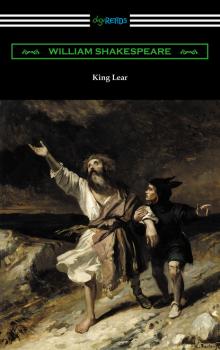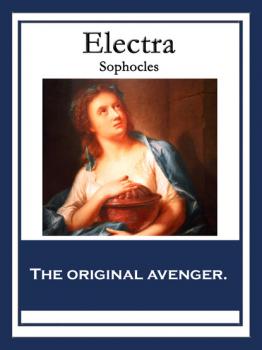Античная литература
Различные книги в жанре Античная литератураKing Lear (Annotated by Henry N. Hudson with an Introduction by Charles Harold Herford)
The historical basis for “King Lear” comes from Geoffrey of Monmouth’s account of the legendary King Leir of the Britons recorded in the historian’s “History of the Kings of Briton.” King Lear is an elderly man and wishes to retire from power. In the decision to divide up his estate he requests that his daughters profess their feelings for him, vowing to give whomever loves him the most the largest share. His two eldest daughters Regan and Goneril go first and based on their responses are rewarded their respective portions. However when it is his youngest daughter Cordelia’s turn, she refuses to flatter her father as her older sisters have done, insisting that there are no words to describe her love. This enrages the King prompting him to disinherit Cordelia and split the remaining inheritance amongst the two eldest sisters instead. As the play progresses, the foolishness of this decision becomes evident, descending the King into madness. In its portrayal of the tragic effect of human weakness and cruelty, “King Lear” has come to be regarded as one of the most powerful of Shakespeare’s works. This edition is annotated by Henry N. Hudson and includes an introduction by Charles Harold Herford.
The Complete Works of Shakespeare (40 works) [Illustrated]
40 of William Shakespeare's major works in one collection with active table of contents:<br><br>All's Well That Ends Well<br>Antony and Cleopatra<br>The Comedy of Errors<br>The Tragedie of Coriolanus<br>Cymbeline<br>The Tragedie of Hamlet<br>The First Part of Henry the Fourth<br>The Second Part of Henry the Fourth<br>The Life of Henry the Fift<br>The first Part of Henry the Sixt<br>The second Part of Henry the Sixt<br>The third Part of Henry the Sixt<br>Julius Caesar<br>The Life of Henry VIII<br>King John<br>The Tragedy of King Lear<br>The Tragedy of King Richard II<br>The Life and Death of King Richard III<br>A Lover's Complaint<br>Love's Labour's Lost<br>Macbeth<br>Measure for Measure<br>The Merchant of Venice<br>The Merry Wives of Windsor<br>A Midsummer Night's Dream<br>Much Ado About Nothing<br>Othello, the Moor of Venice<br>The Passionate Pilgrim<br>The Rape of Lucrece<br>Romeo and Juliet<br>Shakespeare's Sonnets<br>The Taming of the Shrew<br>The Tempest<br>The Life of Timon of Athens<br>The Tragedie of Titus Andronicus<br>The History of Troilus and Cressida<br>Twelfth Night<br>The Two Gentlemen of Verona<br>VENUS AND ADONIS<br>The Winter's Tale <br><br>Illustrated with 10 unique illustrations.
Cinematic Hamlet
Hamlet has inspired four outstanding film adaptations that continue to delight a wide and varied audience and to offer provocative new interpretations of Shakespeare’s most popular play. Cinematic Hamlet contains the first scene-by-scene analysis of the methods used by Laurence Olivier, Franco Zeffirelli, Kenneth Branagh, and Michael Almereyda to translate Hamlet into highly distinctive and remarkably effective films. Applying recent developments in neuroscience and psychology, Patrick J. Cook argues that film is a medium deploying an abundance of devices whose task it is to direct attention away from the film’s viewing processes and toward the object represented. Through careful analysis of each film’s devices, he explores the ways in which four brilliant directors rework the play into a radically different medium, engaging the viewer through powerful instinctive drives and creating audiovisual vehicles that support and complement Shakespeare’s words and story. Cinematic Hamlet will prove to be indispensable for anyone wishing to understand how these films rework Shakespeare into the powerful medium of film.
Shakespearean Tragedy and Its Double
Why does Shakespearean tragedy continue to move spectators even though Elizabethan philosophical assumptions have faded from belief? Shakespearean Tragedy and Its Double seeks answers in the moment-by-moment dynamics of performance and response, and the Shakespearean text signals those possibilities. Shakespearean Tragedy and Its Double investigates the poetics of audience response. Approaching tragedy through the rhythms of spectatorial engagement and detachment ("aesthetic distance"), Kent Cartwright provides a performance-oriented and phenomenological perspective. Shakespearean Tragedy and Its Double analyzes the development of the tragic audience as it oscillates between engagement—an immersion in narrative, character, and physical action—and detachment—a consciousness of its own comparative judgments, its doubts, and of acting and theatricality. Cartwright contends that the spectator emerges as a character implied and acted upon by the play. He supports his theory with close readings of individual plays from the perspective of a particular element of spectatorial response: the carnivalesque qualities of Romeo and Juliet ; the rhythm of similitude, displacement, and wonder in the audience's relationships to Hamlet ; aesthetic distance as scenic structure in Othello ; the influence of secondary characters and ensemble acting on the Quarto King Lear ; and spectatorship as action itself in Antony and Cleopatra . Shakespearean Tragedy and Its Double treats the dramatic moment in Shakespearean tragedy as uncommonly charged, various, indeterminate, always negotiating unpredictably between the necessary and the spontaneous. Cartwright argues that, for the audience, the very dynamism of tragedy confers a certain enfranchisement, and the spectator's experience emerges as analogous to, though different from, that of the protagonist. Through its own engagement and detachments the audience becomes the final performer creating the play's meaning.
"The Farce of the Fart" and Other Ribaldries
Was there more to medieval and Renaissance comedy than Chaucer and Shakespeare? Bien sûr . For a real taste of saucy early European humor, one must cross the Channel to France. There, in the fifteenth and early sixteenth centuries, the sophisticated met the scatological in popular performances presented by roving troupes in public squares that skewered sex, politics, and religion. For centuries, the scripts for these outrageous, anonymously written shows were available only in French editions gathered from scattered print and manuscript sources. Now prize-winning theater historian Jody Enders brings twelve of the funniest of these farces to contemporary English-speaking audiences in "The Farce of the Fart" and Other Ribaldries . Enders's translation captures the full richness of the colorful characters, irreverent humor, and over-the-top plotlines, all in a refreshingly uncensored American vernacular. Those who have never heard the one about the Cobbler, the Monk, the Wife, and the Gatekeeper should prepare to be shocked and entertained. "The Farce of the Fart" and Other Ribaldries is populated by hilarious characters high and low. For medievalists, theater practitioners, and classic comedy lovers alike, Enders provides a wealth of information about the plays and their history. Helpful details abound for each play about plot, character development, sets, staging, costumes, and props. This performance-friendly collection offers in-depth guidance to actors, directors, dramaturges, teachers, and their students. "The Farce of the Fart" and Other Ribaldries puts fifteenth-century French farce in its rightful place alongside Chaucer, Shakespeare, commedia dell'arte, and Molière—not to mention Monty Python. Vive la Farce!
Mary Magdalene and the Drama of Saints
A sinner-saint who embraced then renounced sexual and worldly pleasures; a woman who, through her attachment to Jesus, embodied both erotic and sacred power; a symbol of penance and an exemplar of contemplative and passionate devotion: perhaps no figure stood closer to the center of late medieval debates about the sources of spiritual authority and women's contribution to salvation history than did Mary Magdalene, and perhaps nowhere in later medieval England was cultural preoccupation with the Magdalene stronger than in fifteenth-century East Anglia. Looking to East Anglian texts including the N-Town Plays, The Book of Margery Kempe , The Revelations of Julian of Norwich , and Bokenham's Legend of Holy Women , Theresa Coletti explores how the gendered symbol of Mary Magdalene mediates tensions between masculine and feminine spiritual power, institutional and individual modes of religious expression, and authorized and unauthorized forms of revelation and sacred speech. Using the Digby play Mary Magdalene as her touchstone, Coletti engages a wide variety of textual and visual resources to make evident the discursive and material ties of East Anglian dramatic texts and feminine religion to broader traditions of cultural commentary and representation. In bringing the disciplinary perspectives of literary history and criticism, gender studies, and social and religious history to bear on specific local instances of dramatic practice, Mary Magdalene and the Drama of Saints highlights the relevance of Middle English dramatic discourse to the dynamic religious climate of late medieval England. In doing so, the book decisively challenges the marginalization of drama within medieval English studies, elucidates vernacular theater's kinship with influential late medieval religious texts and institutions, and articulates the changing possibilities for sacred representation in the decades before the Reformation.
The Persistence of Allegory
In an impressively comparative work, Jane K. Brown explores the tension in European drama between allegory and neoclassicism from the sixteenth through the nineteenth century. Imitation of nature is generally thought to triumph over religious allegory in the Elizabethan and French classical theater, a shift attributable to the recovery of Aristotle's Poetics in the Renaissance. But if Aristotle's terminology was rapidly assimilated, Brown demonstrates that change in dramatic practice took place only gradually and partially and that allegory was never fully cast off the stage. The book traces a complex history of neoclassicism in which new allegorical forms flourish and older ones are constantly revitalized. Brown reveals the allegorical survivals in the works of such major figures as Shakespeare, Calderón, Racine, Vondel, Metastasio, Goethe, and Wagner and reads tragedy, comedy, masque, opera, and school drama together rather than as separate developments. Throughout, she draws illuminating parallels to modes of representation in the visual arts. A work of broad interest to scholars, teachers, and students of theatrical form, The Persistence of Allegory presents a fundamental rethinking of the history of European drama.
Oedipus at Colonos
Oedipus was the son of King Laius and Queen Jocasta. Before he was born, his parents consulted the Oracle at Delphi. The Oracle prophesied that Oedipus would murder his father and marry his mother. In an attempt to prevent this prophecy's fulfillment, Laius ordered Oedipus's feet to be bound together, and pierced with a stake. Afterwards, the baby was given to a herdsman who was told to kill him. Unable to go through with his orders, he instead gave the child to a second herdsman who took the infant, Oedipus, to the king of Corinth, Polybus. Polybus adopted Oedipus as his son. Oedipus was raised as the crown prince of Corinth. Many years later Oedipus was told that Polybus was not his real father. Seeking the truth, he sought counsel from an Oracle and thus started the greatest tragedy ever written. The middle of the three Theban plays, ‘Oedipus at Colonos’ (Colonus) describes the end of Oedipus' tragic life, during which the blinded Oedipus discusses his fate as related by the oracle, and claims that he is not fully guilty.
King Oedipus
Widely regarded as one of the greatest Greek tragedies, ‘King Oedipus’ (or ‘Oedipus Rex’) is the first play in the Oedipus trilogy (followed by ‘Oedipus at Colonus’ and then ‘Antigone’). After defeating the Sphinx and freeing the kingdom of Thebes from her curse, the flawed hero unwittingly fulfills a prophecy that he would kill his father and marry his mother.









